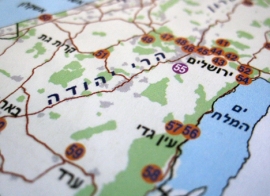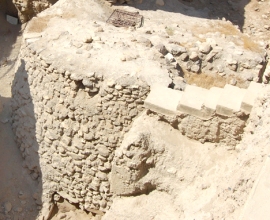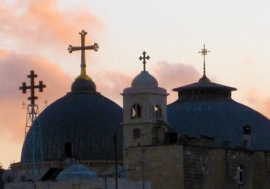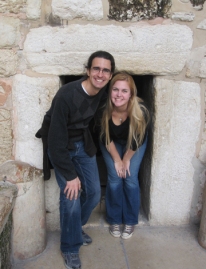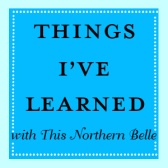 When I was deciding on who I wanted to have guest post while I was gone on the honeymoon, I knew right away I wanted this girl. Jessa Barniol abides over at Shalom sweet Home. I love reading about her adventures and new life over in Jerusalem. Keep reading and you’ll see why you need to be following Jessa on her adventure!
When I was deciding on who I wanted to have guest post while I was gone on the honeymoon, I knew right away I wanted this girl. Jessa Barniol abides over at Shalom sweet Home. I love reading about her adventures and new life over in Jerusalem. Keep reading and you’ll see why you need to be following Jessa on her adventure!
Take it away Jessa!
There was this one time, a few months ago, when my husband and I rented a car to drive north to the Sea of Galilee, and the car rental place helpfully gave us a map to help us on our way. Later, we got a little lost and decided to refer to the map. And we suddenly realized the map was all in Hebrew.
Two years ago, Hebrew to me looked more like a secret code than a foreign language. Two years ago, I would have panicked. Two years ago, I had no idea what “beseder” or “khalas” or “meshuggah” meant. (That’s “fine” in Hebrew, “enough” in Arabic and “crazy” in Yiddish, all words that I now use regularly in everyday conversation. And I ended up doing okay with the map in Hebrew, too.)
Two years ago, I never would have even dreamed that the Sea of Galilee was a place that one could rent a car and drive to. Two years ago, the Holy Land seemed to me like Narnia or Middle Earth: a mythical, magical place that only existed on paper. Now I know that it is, indeed, mythical and magical, but it’s also a place where they put tuna on pizza (it’s a kosher thing), where people yell at you even when they’re happy, and where public transportation often runs behind schedule. Way behind schedule.
Now I know that Israel is real. Palestine is real. Jerusalem is real.
Two years ago, my husband and I left Texas for Jerusalem, thanks to his job. And for two years, we have been in a constant state of amazement, walking in the places where Jesus literally walked. And picking the tuna off our pizza.
We have learned to advise people to avoid the “Jerusalem Mixed Grill” at restaurants (unless you’re fond of the, shall we say, “leftover” parts of a chicken). We can tell the difference between the good and bad falafel, the Arab and Jewish villages, and a number of different types of Orthodox Jews from a very long way away. And if you name any story in the Gospels, we can take you right to the place where it happened. Maybe even without a map.
You may never be offered the Jerusalem Mixed Grill or have to decipher a map in Hebrew, but some of the most interesting lessons we have learned here are things that everyone should know. Here are a few I want to share with you.
The world (and human history) is old. Like, really, really old.
Back when we lived in Texas, I worked at a trade organization that was celebrating its 125th year and it was a really big deal.
But 125 years? Really? Puh-lease. Here in Jerusalem, we have iron house keys older than that gathering dust in souvenir shops in the Old City. (And if you act unpleased about the price and pretend to walk away, the guy will give them to you for 25 shekels, which is about a fourth of the going price for a bottle of contact solution in a local pharmacy.)
The current walls of the Old City were built in the 1530s, and no one even blinks at them because they’re among the newest historical remains in the whole city. Think about that for a second. St. Augustine, Florida, the oldest European settlement in the United States and a really big deal, was built three decades after that, in 1565. Jamestown wasn’t founded until 1607. That’s the American version of “old.”
This is our version of “old.” In nearby Bethlehem, we have one of the oldest churches in the world; the Basilica of the Nativity, which was first constructed in the year 325. (Yes; three, two, five. That’s a year.) It has been a functioning church continuously since then, for nearly 1,700 years. Our version of “old” might also be the first-century Herodian buildings that are commonplace throughout the whole country, or the thousand-year-old buildings built over the ruins of the two-thousand-year-old buildings. Our version of “old” is literally the Oldest Known Building in the World; a 10,000-year-old guard tower in Jericho, in the Palestinian Territories. As far as historians know, those ancient peoples of Jericho may have been, literally, the first human beings to stick their heads out of the caves they had been living in and say, “Hey, we could live out here, above the ground!”
Sort of boggles the mind, doesn’t it?
As Catholics, we have inherited a lot from our Jewish brothers and sisters.
Have you ever been inside of a synagogue? At the front, in a place of honor, is a large silver box. Very special, very sacred. It is only opened with great ceremony and honor, and it is an integral part of regular worship. It houses the Torah scroll; the Word of God in physical form.
Sound familiar? What about a Catholic Church? Often at the front, in a place of honor, a silver box. Very special, very sacred. Only opened with great ceremony and honor. An integral part of regular worship. It houses the consecrated Eucharist, the Word of God in physical form; the Word of God made flesh, who made his dwelling among us, (John 1:14) and continues to dwell among us in this miraculous form.
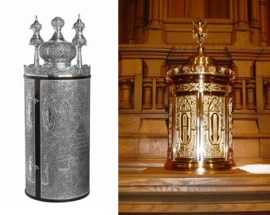
A silver Torah Case from a synagogue and a golden Tabernacle from a Catholic church. See any family resemblance?
Many elements of Jewish observance are eerily familiar to Catholics. The Last Supper of Jesus was literally a Jewish Passover Seder, and our weekly remembrance of the Last Supper echoes this celebration in many ways. Jewish views on penance as a public act and the Jewish focus on liturgical “seasons” of prayer, fasting and almsgiving, followed by seasons of rejoicing, also seem oddly familiar. It’s usually hard to say whether these are things that we inherited directly from our own Jewish ancestors, like the Jewish-born apostles and early Judeo-Christians, or things that sort of evolved simultaneously in two faiths, both rife with tradition and history, and sharing common ancestors. But either way, getting to know the faith that was such an integral part of the daily life of Jesus is one of the most amazing parts of spending time in the Holy Land.
Never underestimate the power of a Day of Rest.
One of the things that we didn’t count on before coming here was how much we would be affected by the Jewish observance of “Shabbat,” the Day of Rest for the Sabbath once a week.
From sunset Friday to nightfall Saturday, observant Jews will not perform any acts in a certain class of creative work, including driving, writing, cutting, cooking, exchanging money or turning on lights. This also means the entire city of Jerusalem shuts down. No public transportation, no stores or businesses open, literally nothing to do.
My husband works on Sundays, because the national weekend includes the Sabbath on Saturday and the Day of Preparation on Friday. So, we often attend Saturday Vigil Mass at the nearest Catholic church with Mass in English, about 5 kilometers away. And we walk there because we have no car and there is no public transportation. Yet, rather than being a burden, this is one of our favorite things about the week. It has strengthened our marriage and our calves, and caused us to seriously rethink some of our priorities. A day of rest is good for everyone; good for families, kids, the environment, society, and one’s relationship to God. Shouldn’t we try to incorporate some aspect of that into our own weekly lives?
There are more types of Christians than you ever thought possible.
The Church of the Holy Sepulchre, an ancient church that houses both the hill of Calvary, where Jesus was crucified, and his empty tomb, where he was buried and resurrected, is shared between six different Christian denominations.
Quick, name six different Christian denominations.
(By the way, none of them are Protestant. Can you name six different non-Protestant Christian denominations?)
More than half of the Christians in the Holy Land celebrate Christmas and Easter on a different day from Catholics and Protestants. Meanwhile, there is also an Orthodox denomination that still conducts its high liturgies in a form of Aramaic; the colloquial language that Jesus spoke with his disciples. And there are churches with married priests… and those married priests and their rites are in full communion with the Catholic Church in Rome, and with us.
You have brothers and sisters in faith that you have never even heard of; Christians who serve the Lord with fasts from all meat and all dairy during all of Lent, who pray with icons and give communion with a spoon, who wait every single year on the Easter Vigil Saturday for a miracle in Christ’s empty tomb; a miracle that comes every year without fail. There are churches that trace their heritage all the way back to Saint Mark or Saint Andrew or Saint Philip, the way we trace ours back to Saint Peter. In Jerusalem, the Body of Christ includes thousands of visiting or transplanted Christians from many different countries, as well as both Palestinian Christians who can trace their ancestry back to the earliest Christians in the whole world and a very small handful of Messianic Jews who fully embrace both Jesus and his Jewish heritage.
Our family of believers is big, beautiful and chaotic, full of ancient traditions and beautiful heritage. Get to know them.
Don’t be afraid of getting lost.
Life is funny, just like Jerusalem. Hiding just under the surface of the things you see everyday are amazing miracles. You never know what you’ll find around the next corner. Will you find a dead end? Will you find an amazing view, or a trash heap, or a little old lady selling the most delicious figs you’ve ever tasted? Or will you find that thing that you will carry with you the rest of your life and look back on with gratitude and awe in your old age?
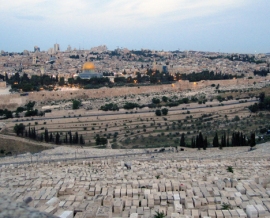
“If I forget you, Jerusalem, may my right hand forget. May my tongue stick to my palate if I do not remember you.” Psalm 137
One never knows. But don’t be afraid of being handed a map in a very foreign language. Lose the map, take the time to wander and wonder, and put your trust in God. Amazing things will happen.
Jessa Barniol is the only blonde and the only American living in her Jerusalem apartment building, where she loves to garden (on her third-floor balcony), send snail mail, and drink tea from all over the world. She loves her Ecuadorean husband, bright colors and beautiful fonts (she daylights as a graphic designer), and the Catholic faith, which she converted to in college. She blogs about her adventures in the Holy Land at Shalom Sweet Home.

